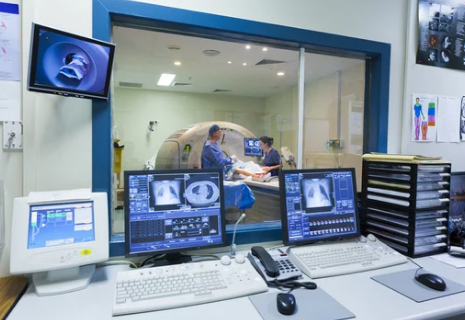Magnetic Resonance Imaging (MRI) is one of the most advanced tools in modern medicine, allowing doctors to see inside the human body with remarkable clarity. While its primary role has been in healthcare, the underlying physics behind MRI—particularly the manipulation of strong magnetic fields—has far-reaching implications beyond hospitals. One of the most exciting applications lies in the pursuit of controlled nuclear fusion, a clean and virtually limitless source of energy that scientists have been chasing for decades.
This article explores how MRI technology, high-field magnets, and advanced imaging techniques are helping shape the future of nuclear fusion, potentially unlocking solutions to one of humanity’s greatest challenges: sustainable, carbon-free energy.
Understanding the Basics of Nuclear Fusion
What Is Nuclear Fusion?
Nuclear fusion is the process that powers the sun and stars. It occurs when two light atomic nuclei combine to form a heavier nucleus, releasing an enormous amount of energy. On Earth, researchers aim to replicate this process using isotopes of hydrogen—deuterium and tritium—as fuel.
Unlike nuclear fission, which splits atoms and produces long-lived radioactive waste, fusion is safer and cleaner. Its byproduct is primarily helium, an inert gas. However, the main challenge is containing and stabilizing plasma, the extremely hot, electrically charged gas where fusion reactions occur.
Why Containment Is Difficult
Fusion plasmas must reach temperatures exceeding 100 million degrees Celsius, hotter than the core of the sun. No material can withstand direct contact with such heat, so scientists rely on magnetic confinement to keep plasma suspended inside a reactor without touching the walls. This is where lessons from MRI technology come into play.
The Role of MRI in Advancing Fusion Research
High-Field Magnets: From Imaging to Plasma Control
MRI scanners use superconducting magnets to generate powerful, stable magnetic fields that align hydrogen protons in the body. In fusion reactors, similar superconducting magnets are essential for creating magnetic “cages” that confine plasma.
- MRI magnets typically operate at 1.5 to 7 Tesla.
- Fusion magnets in experimental devices like ITER or tokamaks can reach up to 20 Tesla.
The engineering challenges are comparable—cooling superconductors to cryogenic temperatures, maintaining field stability, and reducing energy losses. Advances in MRI have directly influenced the design and efficiency of these fusion magnets.
Real-Time Plasma Imaging and Diagnostics
MRI revolutionized healthcare by providing non-invasive imaging of tissues. In fusion, researchers apply similar principles to develop plasma imaging systems. These systems help monitor plasma behavior in real-time, detect instabilities, and guide adjustments to maintain stability.
For example:
- Magnetic resonance diagnostics can reveal how plasma particles move inside a reactor.
- Advanced sensors and imaging tools inspired by MRI improve precision in controlling plasma shape and position.
The Synergy Between Medicine and Energy Technology
Superconducting Materials Innovation
Both MRI and fusion rely on superconductors to generate magnetic fields. Continuous improvements in superconducting wire, such as high-temperature superconductors (HTS), benefit both industries. HTS allows stronger fields with less cooling, reducing operational costs for MRI machines and enabling next-generation compact fusion reactors.
Computational Modeling and AI Applications
MRI technology has also advanced computer modeling and image reconstruction. These computational methods are now being applied to fusion research. Artificial intelligence, used to enhance MRI scans, is helping scientists analyze plasma fluctuations and predict instabilities before they disrupt fusion reactions.
Case Studies: Where MRI Meets Fusion
ITER and MRI-Inspired Technology
The ITER project in France, the world’s largest experimental fusion reactor, relies heavily on superconducting magnets that share design principles with MRI technology. Lessons learned from decades of medical imaging research inform the stability, safety, and efficiency of ITER’s magnet systems.
Compact Fusion Startups
Private companies, such as Commonwealth Fusion Systems (CFS), are working on smaller, more efficient reactors using HTS magnets. These magnets draw inspiration from both MRI machines and advanced particle accelerators, bridging the gap between medical imaging and energy generation.
The Future Outlook: Clean Energy Powered by Magnetic Innovations
The Path to Commercial Fusion
Controlled nuclear fusion is no longer a distant dream. With magnet technology rapidly evolving, fusion reactors are expected to become more compact, cost-effective, and scalable. The key lies in harnessing lessons from MRI’s precision, stability, and magnetic control systems.
Global Implications
If fusion becomes commercially viable, the world will have access to an almost limitless source of clean energy, reducing dependence on fossil fuels and significantly lowering greenhouse gas emissions. MRI technology, originally designed to improve human health, may end up playing a critical role in ensuring the planet’s health as well.
Conclusion: A Shared Magnetic Future
The connection between MRI and nuclear fusion demonstrates how cross-disciplinary innovation drives scientific progress. What started as a medical imaging breakthrough now informs one of the most ambitious energy projects in human history.
By refining magnetic control, imaging techniques, and superconducting materials, MRI technology has paved the way for advances in fusion research. The journey from scanning the human body to stabilizing a miniature star on Earth highlights the power of shared knowledge across fields.
Controlled nuclear fusion may well become the defining energy achievement of the 21st century—and the technology that helps unlock it might just be the same one that looks inside us during a hospital scan.
Also Read :
